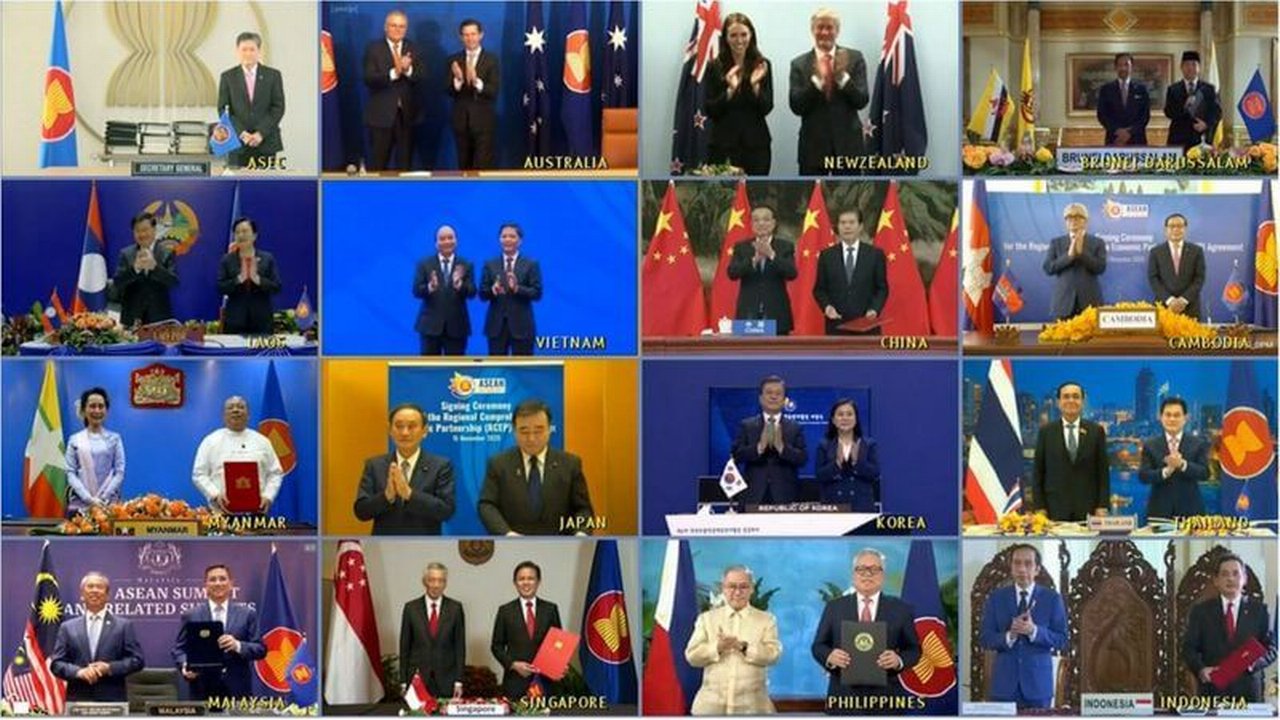November 2020
Fifteen Asia-Pacific economies sign up to the Regional Comprehensive Economic Partnership (RCEP) Agreement in a move back towards multilateral trade and tariff reduction. flow's Clarissa Dann summarises what this means for trade
On 15 November 2020, the Regional Comprehensive Economic Partnership Agreement (RCEP) was signed by national leaders comprising the ten ASEAN countries plus China, Japan, South Korea, Australia and New Zealand.
Although welcome, as reports noted the group of 15 excludes the US, which in 2017 pulled out of a rival Asia-Pacific trade deal – the Trans-Pacific Partnership (TPP) – shortly after Donald Trump took office. But also absent is India, which a year ago decided not to participate in the RCEP.
The signing took place at the end of the 37th ASEAN Summit hosted by Vietnam through video conference.

Fifteen countries sign up to RCEP (source: ASEAN) through video conference
Journey of accord
An initiative first launched during the 2012 ASEAN Summit in Cambodia, negotiations on the RCEP got underway in 2013, and were led by Iman Pambagyo, Director-General of Indonesia’s Ministry of Trade with support provided by the ASEAN Secretariat. After eight years, agreement on creating the world’s largest free trade zone by GDP comes at a time when it can help its member countries recover from the effects of the Covid-19 pandemic and marks a sea-change in a move away from multilateral trade to a trade climate.
RCEP will give a much-needed boost for a swift and robust recovery for businesses and peoples in our region particularly during the current COVID-19 pandemic crisis,” commented Dato Lim Jock Hoi, Secretary-General of ASEAN.
flow’s trade correspondent, Dr Rebecca Harding of Coriolis Technologies reflects, “RCEP is an ambitious trade agreement that is of roughly the scale in trade terms as the EU. Most importantly, it includes China and gives scope across the region for supply chain distribution. Intra-regional trade has been growing significantly over the past few years since the beginning of the trade war between China and the US. The move to a full free-trade area will hasten this growth meaning that is increasingly self-sufficient.
Dubbed by The Economist as a “tidying up exercise”, RCEP joins the ASEAN and additional Asia-Pacific countries in “one overarching compact” the various free trade agreements (FTAs) between the countries. Importantly, it notes, the agreement breaks new ground in harmonising the disparate rules-of-origin provisions in ASEAN’s various FTAs, and setting regional-content rules so that intermediate goods can be sourced from any of the 15 countries. As a result RCEP is expected to have a noticeable economic impact,” the newspaper adds.1
The agreement takes effect within two years, after it has been ratified by the member countries.
“In light of the adverse impact of the pandemic on our economies, and our people’s livelihood and well-being, the signing of the RCEP Agreement demonstrates our strong commitment to supporting economic recovery, inclusive development, job creation and strengthening regional supply chains as well as our support for an open, inclusive, rules-based trade and investment arrangement,” says the Joint Leaders Statement published on the ASEAN website here.

Figure 1: RCEP trade membership
Source: https://commons.wikimedia.org/w/index.php?curid=57964894
Scope of the agreement
RCEP covers a market of 2.2 billion people – around 30% of the world’s population with a combined GDP of US$26.2trn (30% of global GDP), and represents around 28% of world trade (based on 2019 figures).
According to ASEAN statements, the deal will improve market access with tariffs and quotas eliminated in over 65% of goods traded and make business predictable with common rules of origin and transparent regulations, upon entry into force. This, leaders hope, will encourage firms to invest more in the region, including building supply chains and services, and to generate jobs.
The Agreement has 20 Chapters, 17 Annexes and 54 schedules of commitments covering market access, rules and disciplines, and economic and technical cooperation. Specific areas of focus include rules of origin, trade in goods and services, customs procedures, telecommunications, intellectual property, SMEs and competition. A helpful summary of the agreement can be found on the ASEAN website here.
A report from the BBC observed that RCEP will provide a much-needed simplification to the current FTAs, citing the example of how businesses with global supply chains could face tariffs even within an existing FTA because their products contain components made elsewhere.
“A product made in Indonesia that contains Australian parts, for example, might face tariffs elsewhere in the ASEAN free-trade zone. Under RCEP, parts from any member nation would be treated equally, which might give companies in RCEP countries an incentive to look within the trade region for suppliers,” explains the report.2
Accommodation for India
As reported in flow following the GTR India conference in Mumbai, India had decided back in November 2019 not to participate in RCEP. Issues remained on what competitive advantage this would give the world’s fifth-largest economy3 – particularly in technology.
The agreement specifically provides for India joining at a later date. “The RCEP Signatory States will commence negotiations with India at any time after the signing of the RCEP Agreement once India submits a request in writing of its intention to accede to the RCEP Agreement to the Depositary of the RCEP Agreement,” says the Joint Leaders’ Statement.
Editorial opinion in India’s Economic Times states the case in favour of the country signing up. “Keeping environmental and labour norms outside RCEP might seem smart, but would deny companies of RCEP members easy access to Europe and the US. Intellectual property (IP) norms are included, and it would be very much in India’s interest to seek transparency in IP and ‘rules of origin’ issues in RCEP,” notes the publication. However, the Asia Times took a rather different perspective, “New Delhi’s decision owed largely to concerns RCEP participation would expose Indian producers and manufacturers to a flood of cheap and mainly Chinese-made imports, an unequal trade flow Indian officials say would have jeopardized millions of local businesses, industries and jobs.”4
“The RCEP trade deal …makes it easier and cheaper for corporates to do business in and across the region”
Outlook for Asian economies
Expansion of market access for goods and services across Asia was the original objective of RCEP and this looks set to take off.”The RCEP trade deal is a truly important milestone for driving economic integration of the ASEAN region plus China, Japan, South Korea, Australia and New Zealand, ultimately making it easier and cheaper for corporates to do business in and across the region.” concludes Burkhard Ziegenhorn, Head of South-East Asia at Deutsche Bank.
Sources
1 See https://econ.st/35kL2xd, The Economist, 15 November 2020
2 See https://bbc.in/2ILFV0t at bbc.co.uk
3 See https://bit.ly/3kKU63k at weforum.org
4 See https://bit.ly/3kJ2Kiv at asiatimes.com
Go to Corporate Bank EXPLORE MORE
Find out more about products and services
Go to Corporate Bank Go to Corporate BankStay up-to-date with
Sign-up flow newsbites
Choose your preferred banking topics and we will send you updated emails based on your selection
Sign-up Sign-upSubscribe Subscribe to our magazine
flow magazine is published annually and can be read online and delivered to your door in print
You might be interested in
Trade finance and lending
Financing trade’s recovery Financing trade’s recovery
While Covid-19 has shaken trade and trade finance, the industry has the essentials to ride out the storm. The key is to build on momentum gathered since the outbreak and build out the framework for the industry’s long-term digital evolution, explains Deutsche Bank’s Russell Brown
CORPORATES BANK SOLUTIONS
A Guide to Digital Trade Finance A Guide to Digital Trade Finance
Digitalisation has long been a priority for the trade finance industry, with operational efficiency and lower transaction costs among the anticipated benefits. Where has the journey got to? And how have common frameworks evolved? With contributions from experts across the trade finance industry, this Guide to Digital Trade Finance charts the direction of travel
A Guide to Digital Trade Finance MoreTrade finance and lending {icon-book}
Merchants of peace Merchants of peace
Celebrating a century of keeping the peace through supporting international trade, International Chamber of Commerce has a new Finance for Development Hub for tackling modern impediments to financial inclusion and trade facilitation. David Meynell reports



